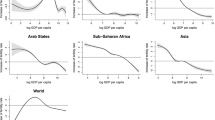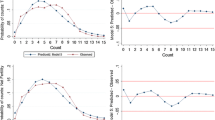Abstract
The demographic transition theory that mortality reduction is followed by fertility reduction is challenged by reports that many developing countries are trapped in the stage of high fertility and lower mortality. We examined the extent to which reduced infant mortality lowers fertility both directly and indirectly relative to other determinants of fertility in developing countries. According to the available information, determinants of fertility were selected. Data from the United Nations on fertility and its determinants in 117 developing countries were analyzed. Remarkable fertility reduction started only when the infant mortality rate was reduced to a certain "threshold" level around 50–125 per 1000 live births. Fertility reduction is related to the level of infant mortality and other socioeconomic variables mainly indirectly through the increase in contraceptive prevalence. Thus, the demographic transition theory is still maintained. Even in the country group which was “trapped” in the stage of “low” mortality of around 125 and high fertility, fertility reduction seems to be possible by further reducing the infant mortality rate, e.g. to lower than 100, which helps increase family planning practices.
Similar content being viewed by others
References
Notestein FW. Population-The long view. In: Schultz TW, ed. Food for the World. Chicago: University of Chicago Press, 1945: 36–57.
Brown LR. Analyzing the demographic trap. In: The Worldwatch Institute, The State of the World 1987. New York: W.W.Norton, 1987: 20–37.
King M. Health is a sustainable state. Lancet 1990; 336: 664–7.
Jolly R. Overpopulation and death in childhood. Lancet 1990; 336: 936.
Bongaarts J, Mauldin WP, Philips JF. The demographic impact of family planning programs. Stud Fam Plann 1990; 21: 299–310.
Cochrane S, Zachariah K. Infant and child mortality as a determinant of fertility: The policy implication. In: Proceedings of the Expert Group on Fertility and Family; 1983 Jan. 5–11, New Delhi, New York: United Nations Department of International Economic and Social Affairs, 1984: 253–277.
Bailey M. Determinants of fertility in a rural society: Some evidence from Sierra Leone. Soc Sci Med 1989; 28: 285–92.
Khor GL. Fertility preferences among Malaysian women: an analysis of responses to the new population policy. J Biosoc Sci 1990; 22: 465–76.
Poston DL, Zhongke J. Socioeconomic structure and fertility in China: A county level investigation. J Biosoc Sci 1990; 22: 507–15.
Hirschman C, Guest P. Multilevel models of fertility determination in four southeast Asian countries: 1970 and 1980. Demography 1990; 27: 369–96.
United Nations. World Demographic Estimates and Projections 1950–2025. New York: United Nations, 1988.
United Nations. Population Fund: State of World Population 1992. New York: United Nations, 1992.
Grant J. The State of the World’s Children 1991. United Nations. Children’s Fund. New York: Oxford University Press, 1991.
United Nations. National Accounts Statistics: Analysis of Main Aggregates 1988-1989. New York: United Nations, 1991.
Pendleton BF, Yang SW. Socioeconomic and health effects on mortality declines in developing countries. Soc Sci Med 1985; 20: 453–60.
Jejeebhoy S. The shift from natural to controlled fertility: A cross-sectional analysis often Indian states. Stud Fam Plann 1984; 15: 191–8.
Mason KO. The impact of women’s social position on fertility in developing countries. Sociological Forum 1987; 2: 718–45.
Potter RG. Birth intervals: Structure and change. Pop Stud 1973; 17: 155–66.
Rao KV, Beaujot R. Effect of infant mortality on subsequent fertility in Pakistan and Sri Lanka. J Biosoc Sci 1986; 18: 297–303.
United Nations. Levels and Trends of Contraceptive Use as Assessed in 1988, Population Studies no. 110. New York: United Nations, 1989: 17–27.
Bongaarts J. Implications of future fertility trends for contraceptive practice. Population and Development Review 1984; 10: 341–52.
Author information
Authors and Affiliations
Rights and permissions
About this article
Cite this article
Shimouchi, A., Hayashi, K., Ozasa, K. et al. Effects of infant mortality, family planning and socioeconomic factors on fertility reduction in developing countries. Environ Health Prev Med 1, 39–43 (1996). https://doi.org/10.1007/BF02931171
Received:
Accepted:
Issue Date:
DOI: https://doi.org/10.1007/BF02931171




